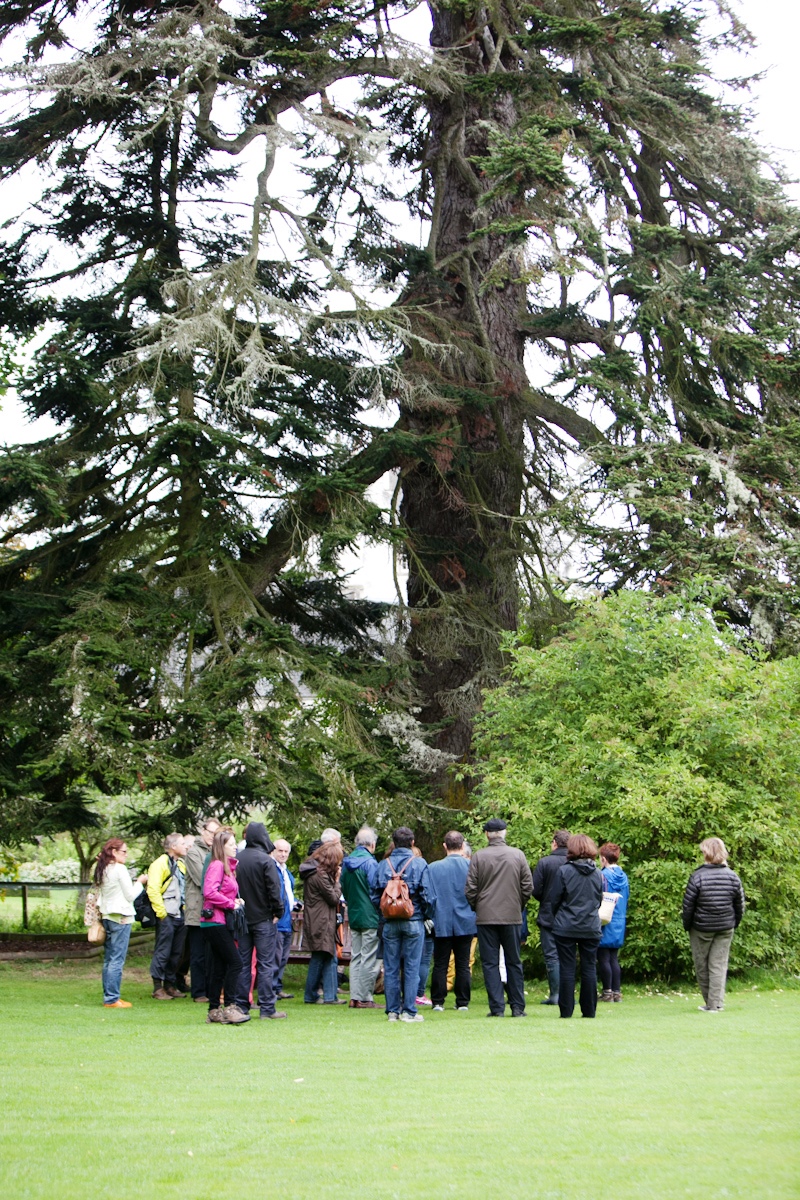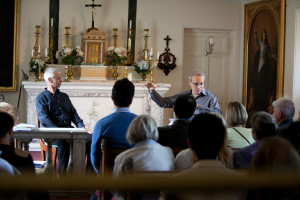
La 4ª Llibres, Borders and Bikes Festival es va celebrar en la més llarga estatge habitada d'Escòcia, Traquair House al riu Tweed a les fronteres escoceses. Organitzat per Beyond Borders Escòcia és un festival únic de la literatura i el pensament que reuneix escriptors principals, polítics, soldats, lawyers and artists to discuss topics relevant to international relations Scotland’s role in the world. Two talks “Understanding the Islamic World” and “Iraq Ten Years On: Quines lliçons per a Síria i el U.N.?"Donar testimoni de l'amplitud de la discussió. SNSI coordinator, Robert Wild participar en dos esdeveniments; un passeig titulat "Si els arbres poguessin parlar – què dirien?", i una xerrada sobre la "Neurociència dels Llocs Naturals antiga i sagrada".

The group on the trail with Ian Edwards, el cap dels esdeveniments al Royal Botanic Garden Edinburgh, discutir l'associació cultural dels arbres, mentre que Caterina Maxwell la família ha estat en residència per 300 anys sempre que la història dels arbres. (Fotos cortesia Beyond Borders)
El diumenge al matí a peu era "Un projecte de la ciència que parla"En col · laboració amb el Reial Jardí Botànic d'Edimburg. Va explorar paisatge històric de Traquair i descobrir les històries dels seus increïbles arbres (www.traquair.co.uk). Ian Edwards, el cap dels esdeveniments al Royal Botanic Garden Edinburgh, portat a la xerrada sobre la història bio-geogràfica i l'associació cultural dels arbres de la finca, incloent Yew, Cal, Silver Fir and Hazel. Catherine Maxwell Stuart, propietari i la família ha estat en residència per 300 anys sempre que la història dels arbres.
El grup va finalitzar amb un debat en el lloc contemplativa creat pels teixos antics que poguessin haver sobreviscut des de l'època de la Selva Ettrick ara clar en què la Casa Traquair - un pavelló de caça dels reis escocesos ja que al voltant 1107 – was originally been situated. Robert posed that if trees could talk they may have a few questions of us like: Què li vas fer a Ettrick Bosc? Què dimonis li has fet a la meitat dels boscos del planeta? S'imagina vostè s'ocupa de nosaltres, els arbres? Really we look after you!
Following the walk the talk took place inside the packed Chapel. Entitled “La Neurociència dels Llocs Naturals antic i sagrat: Lallocs antics hi evoquen una poderosa influència sobre la nostra cultura, com i han de ser protegits en temps de conflicte ", the talk explored Sacred Natural Sites and made links to the emerging understanding of Neuroscience.
Robert kicked off saying that Sacred Natural Sites can be described as places where the human mind meets Nature. He observed that the Traquair chapel (que és relativament nova adaptada per a aquest propòsit a la 1829) tingut poques indicacions de la naturalesa, sinó que el més probable és que tots els nostres espais sagrats deriven originalment de la natura.
Robert va passar a descriure els llocs naturals sagrats era i per què s'han guanyat l'interès del moviment internacional de la conservació. Nature conservation practitioners have a very pragmatic interest in sacred natural sites as they protect a wide range of rare species. This is particularly important as we have now entered the 7ª gran esdeveniment d'extinció, with hundreds of species becoming extinct daily. Beyond this, però, llocs naturals sagrats també integrar un profund conjunt d'arquetips de les relacions humanes que puguem aprendre d'en l'establiment d'un camí més sostenible per a la humanitat.
Un d'aquests concepte és el de "Santuari" that seems to be a direct import from ancient European sacred groves into the early Christian church. Sanctuary arose in the sacred groves of Europe where, no hunting was allowed and if a hunted animal found refuge in a sacred grove the hunt had to stop. Human fugitives could also find sanctuary in the sacred grove. Many of these provisions still hold in the sacred groves of Africa and Asia. At some point this sanctuary principle transferred into the church.

Before getting into the neuroscience of the sacred, Robert salvatge (esquerra) explored sacred sites as potential areas for limiting conflict. (Fotos cortesia Beyond Borders)
Finalment, i abans d'entrar a la neurociència del sagrat, Rob focused on sacred sites as potential areas for limiting conflict. Rob presented an example recently shared by colleagues at the Aigine Cultural Research Centre pel que fa a 2010 Conflicte del Kirguizistan, on centenars de persones van morir i milers de desplaçats en un conflicte entre kirguisos i uzbeks al sud del país. Molts dels habitants desplaçats van trobar refugi en un lloc sagrat per ser un refugi segur en temps de conflicte:
"Kamchieva Mopasha les novel · les uzbeks ètnics i 'shaiyks'O tutor del lloc estats: “Quan hi ha un desastre, la gent ve a aquest santuari i troben refugi ". According to her, a l'altura del conflicte al juny 2010, [moltes persones] Vam anar allà dos uzbeks i kirguisos, però no estaven demanant qui és qui, [però] juntament ofert un sacrifici a Déu, advocant pel restabliment de la pau i l'harmonia. Molts pelegrins s'havien quedat per als dos o tres dies [dels conflictes] en la vora de la Mazar (lloc sagrat). As [un dels entrevistats] Akbarov Salbar said, "Ni un nas o una boca resultat ferit". Un altre entrevistat va dir que els llocs sagrats són zones de no-violència, and moreover places where steps are taken to overcome violence”.
At this point Robert then handed over to Tim Phillips. Tim is an international peace maker and co-founder of the Projecte de la Universitat de Harvard sobre la Justícia en Temps de Transició i ha participat en moltes negociacions de pau entre ells Irlanda del Nord, Sri Lanka i Orient Mitjà.
Tim introduced the emerging discipline of neuroscience and discussed recent lessons that are being learnt in relation to conflict resolution. This includes that different types of thought pattern are processed in different parts of the brain. Different parts of the brain process different emotions and thoughts that are analogous the stages of evolution. Rational thought is now understood to be processed in a different part of the brain that deeply held and sacred values. These new understandings have profound implications for the way that we negotiate over issues. This is the case when seemingly rational solutions to deeply held or sacred values will not be easily considered by negotiating teams.
Sacred natural sites have been contested lands at the same time locations of peace and cooperation. They also embed critical models of human relationships with nature. At a time when our relationships with nature need significant healing; l'espiritual, coneixement científic i social de la conducta humana i l'acció són essencials.






